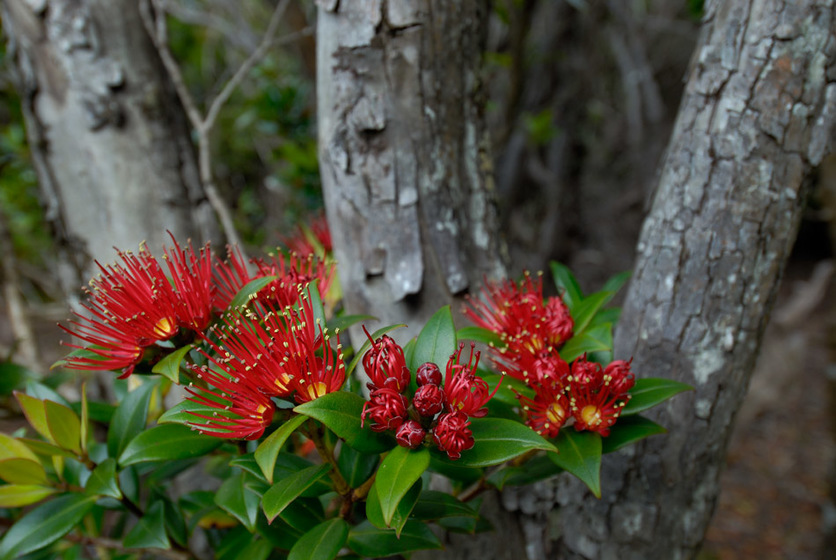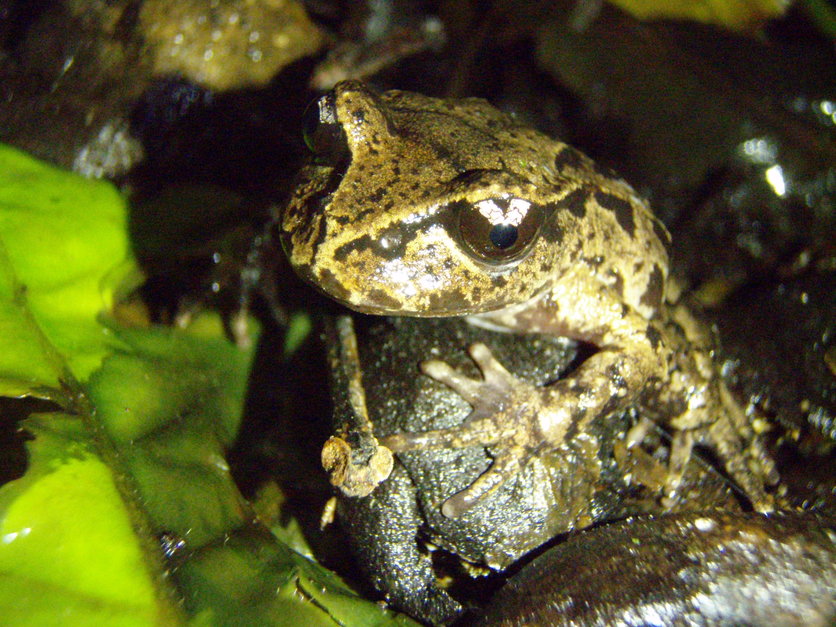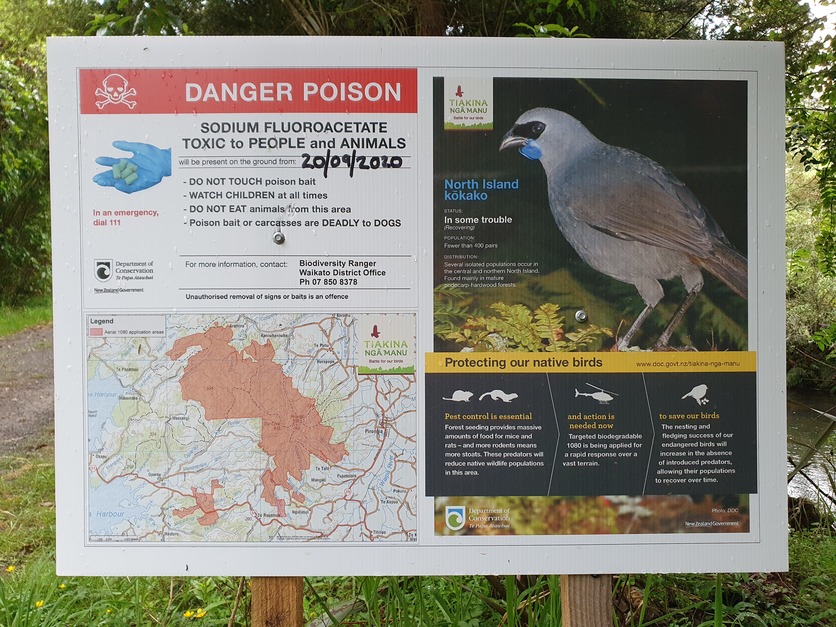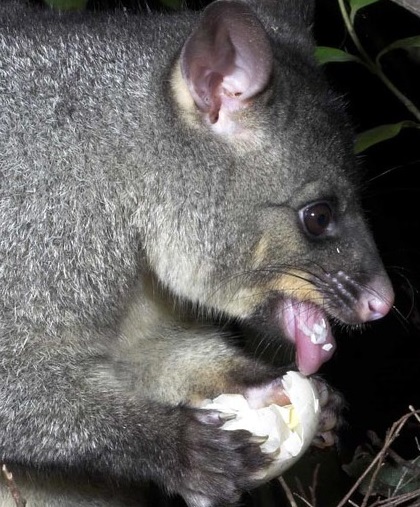1080, or sodium fluoroacetate, is a poison used to control pest species. It is the salt form of a naturally occurring toxin found in poisonous plants in South America, Africa and Australia.
New Zealand’s pest problem
Possums, stoats, ferrets and rats are introduced species that have become significant pests in New Zealand. They eat an estimated 26 million native bird eggs or chicks every year. Possums also destroy 21,000 tonnes of native forest daily (more than the weight of two school buses). They eat leaves, berries, fruit and flowers. This takes food away from native animals and prevents plants from reproducing. Possums have caused catastrophic dieback in rātā-kāmahi forests.
Possums, ferrets and wild deer also threaten our multi-billion dollar meat and dairy industry. They carry bovine TB – a disease that affects a wide range of wild and domesticated animals, including cattle and farmed deer. The disease is infectious and primarily affects the animals’ airways and lungs. When a case of infection is identified, animal movements in the area are restricted, wider testing takes place and infected animals are culled.
Farm animals come in contact with bovine TB where farmland is bordered by forest with TB-infected possums, ferrets or deer. TB-infected possums live in about 40% of New Zealand.
Why use 1080?
Many of New Zealand’s native species are endemic and unique due to millions of years of isolation. They did not evolve to defend themselves from mammalian predators.
Conservation group Forest & Bird reports that our unique native species are in crisis and that 80% of birds, 88% of lizards and 100% of frogs are under threat of extinction. Pest predators also prey on many of our invertebrates and native plants – all of which contribute to the health of our natural ecosystems.
New Zealand farming is also affected when introduced pests spread bovine TB.
New Zealand uses 1080 to control pest mammals. It is used more widely here than in any other country because New Zealand has no indigenous land mammals except for bats, fur seals and sea lions.
Who uses 1080?
1080 is a controlled substance and can only be used by licensed operators. This makes it the most regulated pest control poison in New Zealand.
The Department of Conservation (DOC), Operational Solutions for Primary Industry (OSPRI) and regional councils are the primary users. They use a combination of bait stations and traps where possible and aerial bait operations in inaccessible and remote areas. 1080 is one of 11 poisons used by DOC.
One-third of New Zealand is made up of public conservation land – more than 80,000 km2 – but only 12.5% of this receives any predator control. About 5% of conservation land (4,000 km2) is treated with 1080 in a normal year. OSPRI uses predator control on 35,000 km2 annually. Regional councils sometimes use pest control on regional parkland and public reserves that they manage and, with permission, on private land.
In New Zealand, 3,500,000 kilograms of pesticide is used every year, and the amount of 1080 used is less than one-thousandth of this – about 3,000 kilograms.
Dr Jan Wright, Parliamentary Commissioner for the Environment
Assessing 1080 use in New Zealand
In 2006, the Environmental Risk Management Authority (ERMA) was asked to reassess 1080 use. There was wide consultation, with ERMA reporting it was the most extensive public hearing process in its history. The review found that the benefits of 1080 use outweighed the adverse effects. However, the review called for tighter controls, better reporting and improved monitoring and communication.
In 2013, the Environmental Protection Authority (EPA – formerly known as ERMA) did a follow-up review. It found the new rules were working and the pesticide industry was serious about improving its operations. The EPA said it had no plans to further reassess 1080.
Dr Jan Wright, Parliamentary Commissioner for the Environment, conducted an independent investigation evaluating the use of 1080 to protect native ecosystems. In her 2011 report, Dr Wright concluded that the use of 1080 should continue. She also made several recommendations to simplify and improve regulations and communications.
Aerial 1080 operations – consultation and notification
The EPA has best-practice guidelines for consultation and communication. The guidelines note that, if an operation is taking place on public land, Māori, neighbours and hunting groups must be consulted and interested community groups should be consulted. Land users need time to move stock, beehives or similar and to protect their dogs. Hunting groups need time to alert members to the risks of hunting after an operation and the risks to their dogs and notification when it is safe to resume hunting.
Public notification is also required:
- There must be notices in newspapers about the application date, substance to be used, appropriate warnings, a description of the target area and the name of the person responsible.
- All owners, occupiers and grazing licence holders of land included in and bordering the treatment area must be notified.
- Signs must be put up at every normal point of entry before the baits are applied. There is a list of information that must be on each sign.
The EPA publishes annual reports regarding operations, communications, monitoring and incidents.
An effective but controversial method
The scientific case for using 1080 is strong – 1080 is very effective when used in a careful and timely manner, it can be used in rugged and inaccessible areas, it does not bioaccumulate in plants or animals, it breaks down quickly in soil and water and does not leave permanent residues, and it is cost-effective.
Aerial use of 1080 is a wicked problem. Most people are uneasy about using poisons on a large scale. Mistakes were made in the past. Human error and non-compliance mean that there will still be risks of bykill to non-target species. However, to prevent the destruction of New Zealand’s unique ecosystems, scientific and government organisations recommend that 1080 continues to be one of the tools used to fight introduced predators.
The scientists and conservation workers that I know look forward to the time when reliable, equally effective alternatives become available – but that time is still, realistically, years away, and frankly, our native ecosystems can’t wait that long.
Dr Alison Campbell, University of Waikato
The interactive timeline below outlines some of the history, science and use of 1080. A full transcript is underneath.
Nature of science
There has been considerable scientific research regarding 1080 and its impacts on plants and animals (including humans) as well as its fate in water and soil. It is the role of science to present the facts and findings. While scientists can make recommendations about the efficacy and use of 1080, it is up to government authorities like the Environmental Protection Authority to regulate and monitor the use of 1080 in New Zealand.
Related content
Learn more about 1080 and pest control in these articles:
- The chemistry of 1080
- 1080 and water quality
- 1080 and the risk to non-target species
- Alternatives to 1080
- 1080 – a wicked problem
Is poisoning pests the Māori way? Tame Malcolm unpacks the claims that using 1080 poison to control pests is ‘un-Māori’ – arguing that to the contrary, protecting the environment is at the heart of whakaaro Māori.
Watch scientists from TBfree New Zealand and Landcare Research – Manaaki Whenua talk about innovations in bovine tuberculosis identification and eradication.
Useful links
The Department of Conservation has a pesticide summaries page to help people decide where and where not to go on conservation land. The website includes an interactive map with up-to-date information about where pesticides have been laid or are planned to be laid on conservation land.
The OSPRI website has a list of aerial pest control operations that are under way or planned.
Download the Parliamentary Commissioner for the Environment’s report Evaluating the use of 1080: Predators, poisons and silent forests on this page.
See the 1080 section on the Environmental Protection Authority website, for more see the publications below:
- Communications guidelines for aerial 1080 operations.
- Annual reports on 1080 aerial operations.
Read Dr Alison Campbell’s blog So what does the actual Science say about 1080? for further information and links to relevant scientific research.
See our 1080 pesticide use Pinterest board for more resources.
Read the New Zealand School Journal article The Possum Problem.




